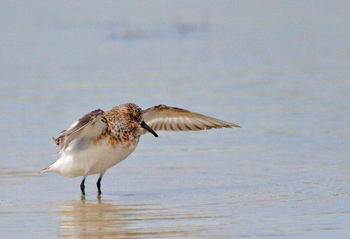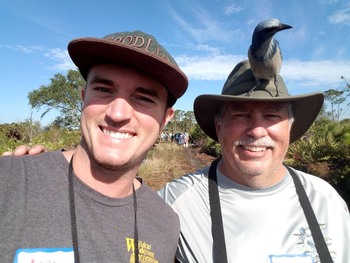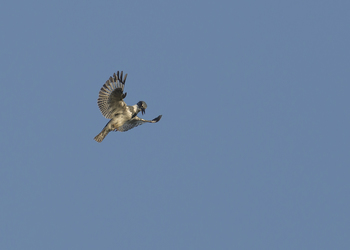 Sanderling by FWC
It’s that time of year again when our migratory birds start to head
south for the winter. In Florida, we are starting to see pushes of warblers and
shorebirds, but soon raptors should be coming through. You may notice these
birds look a bit different than they do in the spring. Many of them are dull looking and lack their
colorful plumage. Many species migrate in their non-breeding plumage and do not
call out, as their purpose is to get to their feeding grounds rather than to
breed.
Fall migrants generally use one of two migration strategies: diurnal or
nocturnal migration. Birds that soar, such as hawks and pelicans, migrate
during the day when there are heat thermals for them to use. Long-distance
migratory land birds, like warblers, migrate at night to avoid predators. For
these species, you may hear them making “flight calls” overhead at night as
they move south.
Look for shorebirds in flooded inland fields and sod farms. These areas
attract lots of shorebirds, including upland, pectoral and buff-breasted
sandpipers. Also, be on the look-out for black-bellied, semipalmated and piping
plovers on both Atlantic and Gulf of Mexico beaches.
As the season progresses, watch how the composition of birds changes
around you. Take note of what species are flying in and which are leaving. You
can track your sightings on eBird.org and
through FloridaNatureTrackers.com.
 Bert and Jordon with a Florida Scrub-Jay
Thank you, Bert Alm, for sharing your story with us!
“I heard of the Wings
Over Florida program at the Space Coast Birding and Wildlife Festival. This festival spurred me to start using eBird. However, it wasn’t till 2017 that I became
more serious about listing the birds I saw. I received a Big Year certificate
for 89 birds in 2016 (all from SCBWF). I set a goal for myself to find over 200
birds in 2017. I was successful and received a certificate for seeing 220 birds
in 2017. For 2018 I have seen 205 birds so far and expect to do better than in
2017. In Florida, I have 243 birds on my life list so far and the 25, 50, 100
and 200 life bird certificates. I have seen 292 life birds in the United
States. Recently I went out of country and now have 310 life birds in the
world.
My goal for 2018 is to
visit at least 100 GFBWTs (Great Florida Birding and Wildlife Trail sites) and
so far, I’ve visited 93. I’m fortunate to live in Brevard County which has 38
trail sites of the 200 in the East Section. This fall I am attending the Florida Birding and Nature Festival in Hillsborough County and will top my goal of 100 trail sites. The
best part of this goal is that I have been able to visit parts of Florida I may
not have thought of visiting. I expect to keep working on this goal well beyond
2018 and eventually see most, if not all, of the GFBWT sites.
I retired in 2016 and
have found life to be busier and more exciting than ever. I enjoy birding and
getting out in nature. There are so many wonderful areas to hike and explore.
It is fun having challenges, it keeps things exciting. It’s also amazing how
helpful people are in the birding community. I have established a lot of new
friendships.
I recently went on my
first butterfly monitoring activity at Merritt Island National Wildlife Refuge. Now, I am keeping a record of what I see. I plan to apply for the
Wings Over Florida butterfly viewing certificates also.
My interest in birding
and experience as a Florida Master Naturalist has led me to join a new
environmental and conservation organization. I am currently the treasurer for Hundred
Acre Hollows, Inc. in Melbourne.
We work closely with the Environmentally Endangered Lands (EEL)
program, Brevard County Natural
Resources, Brevard Zoo and Space
Coast Audubon Society. I hope to have Hundred Acre Hollows added as a
field trip spot for the SCBWF in a couple years and possibly even a future
GFBWT. In just over the past year I’ve seen over 70 species of birds there. I’m
maintaining an eBird list for the site and we’re looking at starting butterfly
monitoring there also.
I truly enjoy the Wings Over Florida program
and tell my birding friends about it all the time. The certificates are
stunningly beautiful, and I am proud to show them off. I look forward to
earning a new Big Year certificate each year as well as achieving the 300 and
400 life bird certificates.
Thanks for this wonderful program.”
If you would like
to share your Wings Over Florida story, please send it to Savanna.Christy@MyFWC.com.
 Belted Kingfisher by Andy Wraithmell
Most anyone that has visited a wetland, stream or lake has heard the wild
rattling call of a belted kingfisher. Belted kingfishers are often seen
flying low over the water with a rapid wingbeat. It is enjoyable watching them
plunge headfirst into the water to grab a fish. Or you may see them perched
high on a snag.
Kingfishers are easily identified as a stocky, large-headed bird with a
shaggy crest and thick bill. Kingfishers are sexually dimorphic. This means
that the females and males exhibit different coloration or other
characteristics. Belted kingfishers are unique in that the females are more
brightly colored than males. Typically, the males in a species are more
colorful. Both males and females are blue-gray with a white breast, but the
females have a rust-colored belt.
Belted kingfishers can be found all over North America. Year-round they
can be found in almost all the contiguous states of the US. During the breeding
season, they can be found further north into Canada and in winter they shift
south and can be found in Central America. For a nest, they burrow into a dirt
bank near water bodies. The tunnels slope upward and can be 1-8 feet deep.
Fun Fact: A 2-million year old kingfisher
fossil was found in Alachua County, Florida!
 Sam Atkins
Hannah Buschert, the Great
Florida Birding and Wildlife Trail Coordinator, recently visited the Blountstown
Greenway/Sam Atkins Park. This is a site in the Panhandle section of the
Birding Trail. It is in Blountstown, about an hour west of Tallahassee in
Calhoun County. The park is mostly forested with a small pond and boardwalk
through the swamp.
There are many places to bird watch at this park, Hannah started off at
the pond where a few people were fishing. She visited in the afternoon, so
there were turkey
vultures, Mississippi
kites and red-shouldered
hawks high in the sky. Common forest birds were easily found: Carolina wren, northern
mockingbird, eastern
towhee and northern
cardinal, along the trails and around the sports fields. Fish crows and mourning doves
were heard nearby.
Not only is this a great birding and butterflying location, the Blountstown
Greenway and Sam
Atkins Park have a plethora of activities to keep you busy. There are sports
fields, fishing, the Panhandle Pioneer Settlement and a paved walking and
biking path. The Blountstown Greenway runs 3.3 miles on an old railroad bed to
the Apalachicola River. Bring your bike and see what Calhoun County has to
offer!
Site Address: NW Silas Green Street, Blountstown, Florida 32424
Contact: (850) 674-4519
Site Hours, Daily: sunrise to sunset
Check out the eBird list
for this park.
September 20 – Bird
Walk: St. Johns County Agricultural Center (St. Augustine, FL)
September 20 – Invasive
Exotic Species and Control Workshop (Okeechobee, FL)
September 20 – Chasing
Warblers (Orlando, FL)
September 21-23 – Lower
Keys Fall Migration Mania (Key West, FL)
September 22 – Bird
Walk and Work Day (Orange Park, FL)
September 22 – San
Felasco Hammock Bird Park (Gainesville, FL)
September 22 – STA
5/6 Driving Bird Tour (Clewiston, FL)
September 22 – National
Public Lands Day (Ocala, FL)
September 22 – EagleWatch
Training (Jacksonville, FL)
These are just a few events listed on our calendar. Check out the event page for more!
Do you know about any other bird or wildlife-related events going on in
Florida? Help spread the word by letting us know! Send in the times, dates,
locations and contacts to Hannah.Buschert@myfwc.com
for posting on the GFBWT website.
Events must be related to birds or other wildlife and must be open to
the public. Examples include interpretive programming, camps and family
programs.
|